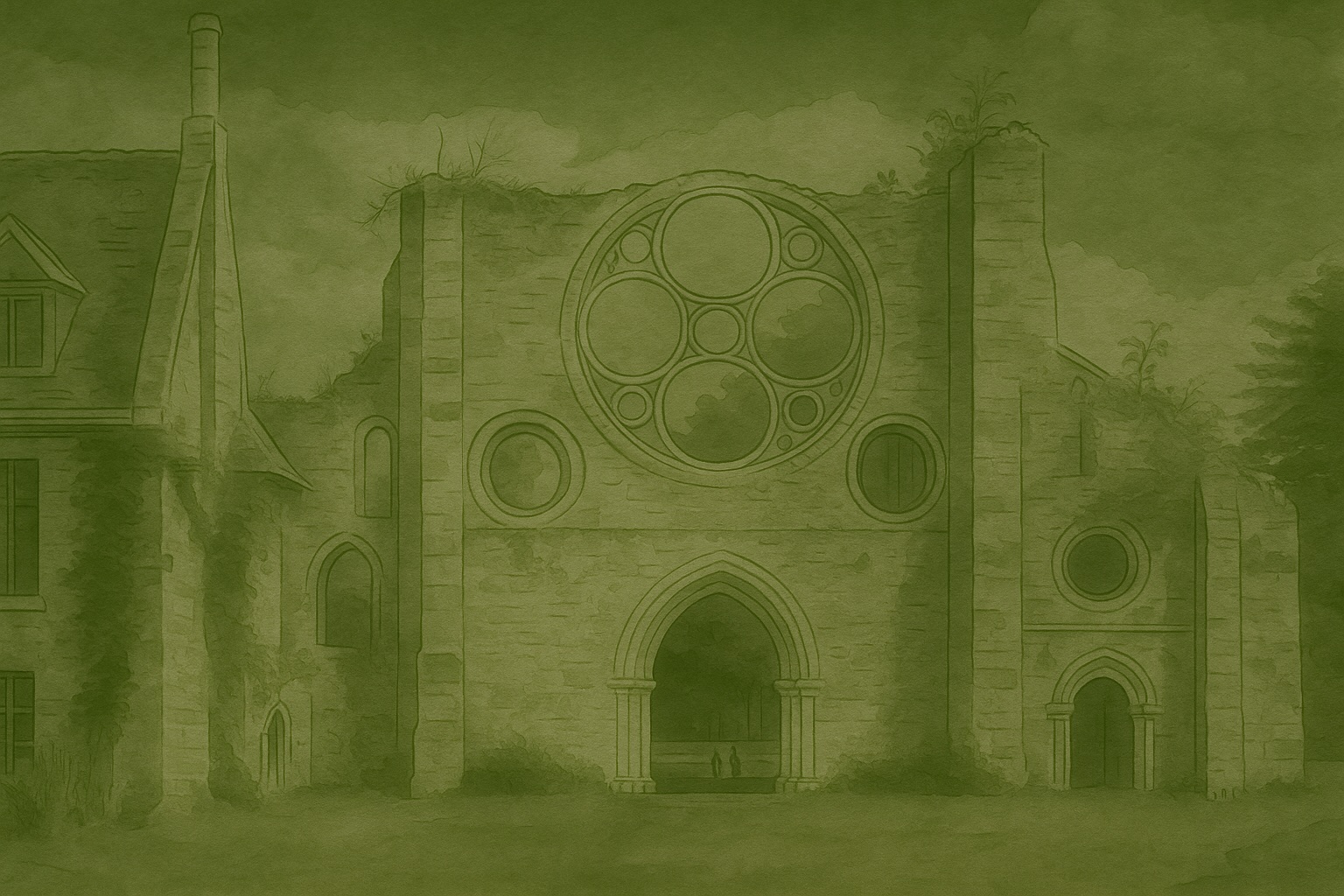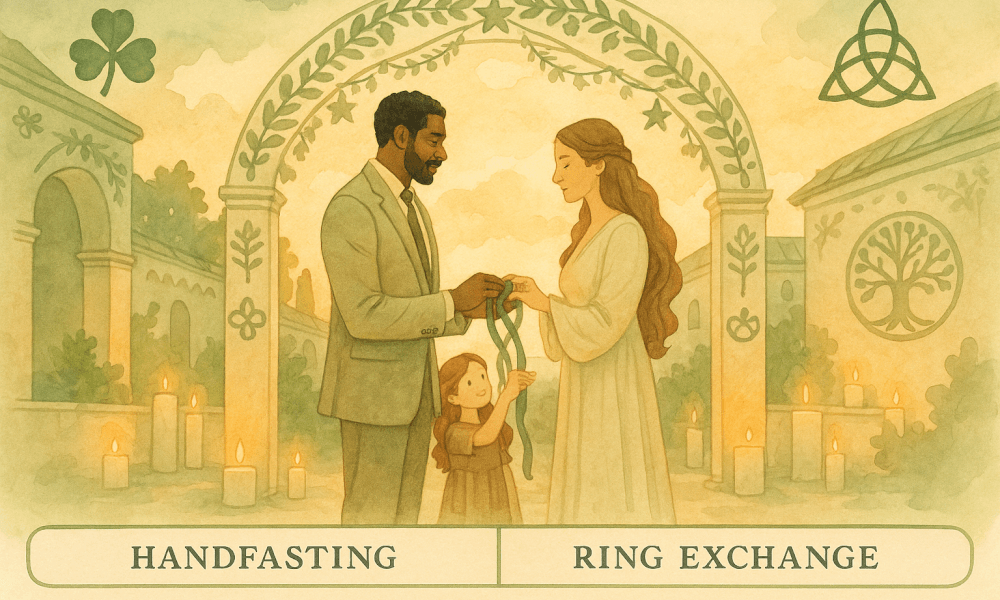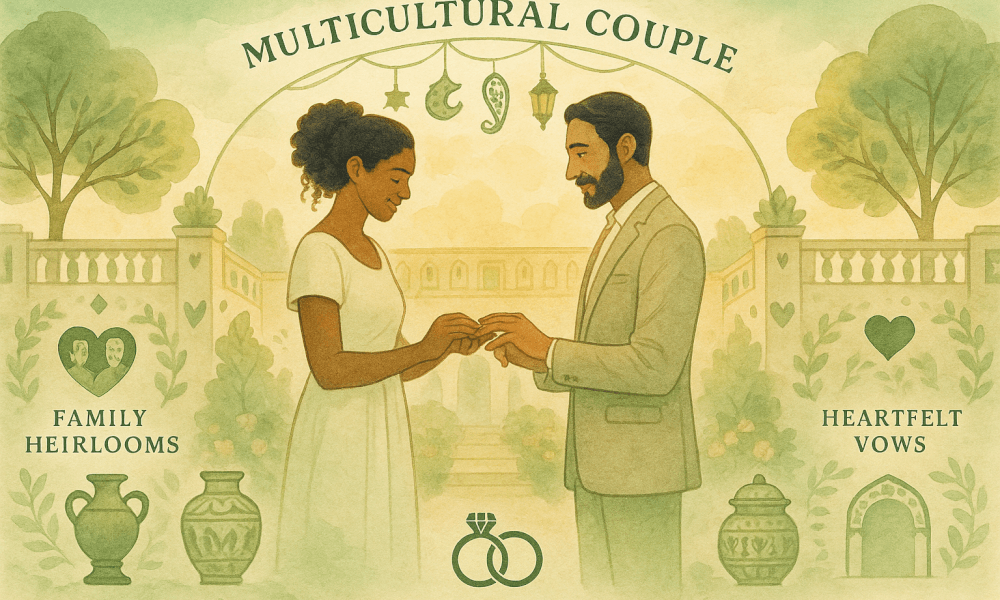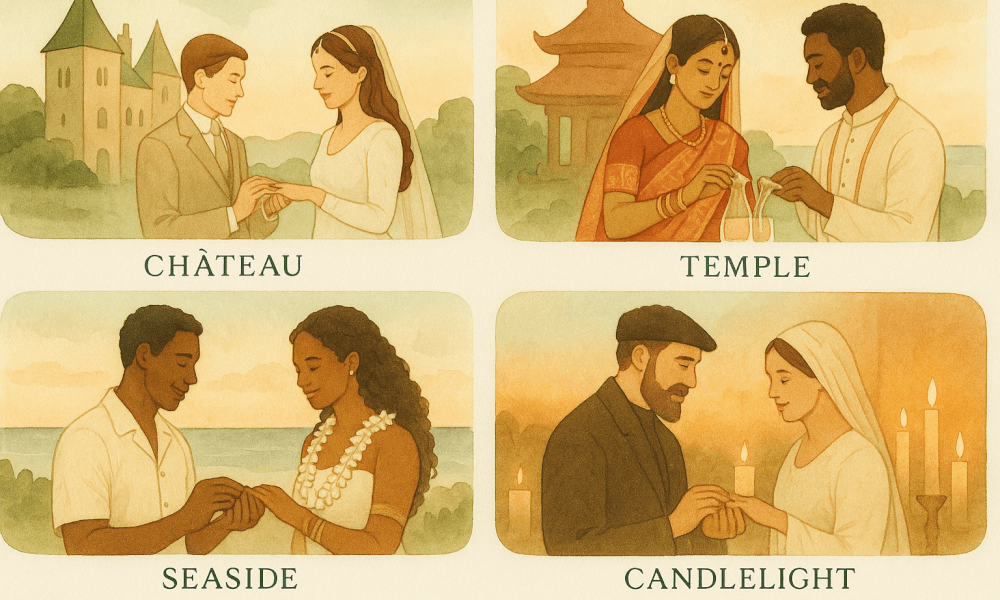Wedding Traditions: 14 Symbols and Customs from Their Origins to Today

The tradition of marriage, whether ancestral or reinvented, is much more than a simple symbolic backdrop to the union of two people. It weaves an invisible thread between generations, cultures and beliefs, each rite carrying a millennia-old story and deep meaning. Over the centuries it has adapted to changing times without losing its soul. From Victorian lucky charms to regional French customs, and rituals from India, Japan or the Celtic lands, each tradition reflects the essence of loving commitment and the richness of intangible heritage. This article invites you to explore, with sensitivity and wonder, the many facets of traditional weddings, to appreciate their beauty and perhaps to incorporate some of their sparkle into your own celebration.
The four traditional wedding elements: origins and meanings
Among these customs, the rule of the four elements holds a special place in the wedding imagination.
The tradition of the wedding with the four elements has its roots in Victorian England. This custom, which appeared at the end of the 19th century, prescribes that the bride wear “ something old, something new, something borrowed, something blue ”. It gradually spread to France at the same time, becoming an indispensable old wedding tradition. Each element carries a specific meaning in these ancestral wedding customs.
The “old” creates a bridge with the family past: a grandmother’s jewelry, an old photograph, or a button sewn into the dress. The “new”—often the dress itself—signals the couple’s future prosperity. The “borrowed” item, lent by a happily married woman, is believed in popular wedding lore to bring luck and happiness. The “blue”, hidden in a garter or a ribbon, symbolizes everlasting fidelity. These four talismans work together as good-luck charms, placing the union under the best auspices in traditional weddings.
The symbolism of wedding traditions: deeper meanings and origins
To understand their coherence, you must go back to the sources.
To grasp the essence of French wedding tradition, one must trace it back to the ancient civilizations of Egypt and Mesopotamia. Marriage then functioned as a social and economic contract between families, aimed at stability and political alliances. In ancient Greece, ceremonies honored Hera and Aphrodite during these sacred wedding rituals. Rome viewed the union as an essential civic duty, establishing marital customs that endured. The medieval Christian Church transformed the institution into a sacrament, creating the tradition of the Christian wedding.
Wedding symbols reflect these varied inheritances: circular rings embody eternity since ancient Egypt; the bouquet toss, originating from pagan rites, passes luck to single guests; the exchange of vows materializes mutual commitment before the community during the nuptial ceremony.
The origin and symbolism of the white dress
Clothing choices say a lot about collective representations.
Contrary to common beliefs about this emblematic nuptial tradition, the white dress did not always dominate ceremonies. In the Middle Ages brides wore their finest clothes, often red or black, reflecting regional wedding traditions of the time. The turning point came in 1840: Queen Victoria married Albert in a white satin dress. This royal innovation, widely publicized by the emerging press, upended wedding dress codes and cultural habits.

White became synonymous with purity and virginity under Catholic influence, marking the symbolism of Western marriage. It also signaled wealth, since a dress that could not be reused demonstrated high social status. Traditional bridal attire thus evolved toward this new norm. Today, even though champagne or colored dresses are gaining ground, white remains the embodiment of the wedding celebration—an old tradition revisited.
Rites of passage in marriage: symbols of union
At the heart of celebrations, some rites give substance to promises.
- The exchange of rings, inherited from ancient Egypt, materializes eternal love through the ring’s endless circular shape
- The sand ritual of Hawaiian origin sees each spouse pour colored sand into a single vessel, symbolizing the inseparable blending of two lives in customary marriage
- Celtic handfasting ties the couple’s wrists with ribbons, creating a tangible knot of their union accompanied by the exchange of vows
- The Indian Saptapadi has the spouses walk seven steps around the sacred fire, sealing their promises for seven future lives according to cultural wedding traditions
- The Japanese San-san-kudo ceremony shares sake between the couple three times, embodying harmony and ancestral respect
- The jumping the broom ritual, a pagan custom, symbolically marks the passage into married life and the couple’s ability to overcome obstacles together
The symbolic meaning of traditional wedding objects
Beyond gestures and words, objects play a central role in the couple’s memory.
Beyond the Anglo-Saxon four elements, the tradition of wedding objects carries a powerful symbolic charge in global wedding heritage. Universal wedding rings embody infinite commitment with their perfect circle. In West Africa, coral bead necklaces protect the couple’s fertility, while heavy gold bracelets display prestige and wealth. The veil, present in many cultures, combines purity and protection against evil spirits according to ancient nuptial traditions. The Western garter adds a playful dimension during the toss to single guests. Traditions for the groom often include a watch or cufflinks passed down as heirlooms, thereby creating a meaningful wedding-with-objects tradition for men.
Each item transcends its material value: a borrowed handkerchief conveys the happiness of a successful union, an antique brooch connects to past generations. These talismans inscribe the wedding into a cultural continuity, blending family heritage, hope for renewal and spiritual protection.
The symbolic meaning of vows and their place in the ceremony
The words spoken seal as much as the gestures.
A pivotal moment in any wedding tradition, the exchange of vows transforms two individuals into a united couple during traditional engagements and then at the wedding. These solemn promises lay the moral and emotional foundations that will guide the future union. Spoken after speeches and before the exchange of rings, the vows publicly mark the commitment to eternal love, loyalty and mutual support.
Reciting them before family and friends strengthens communal belonging, respecting the tradition of marriage regarding who pays what and each person’s responsibilities. Witnesses become guardians of these promises, reminding them of their role in supporting the couple in this French wedding tradition. This oral tradition, present in all cultures, serves as a compass for marriage. It symbolizes the transition to a new chapter where two destinies become permanently intertwined.
What are the most beautiful French and regional traditions?
French wedding traditions: rooted rituals and customs
In France, these practices take very specific forms within legal and festive frameworks.

Beyond the universal symbols explored above, France nurtures unique wedding traditions that respect ancestral marital usages and customs. The publication of the banns is a mandatory step in this traditional marriage. Ten days before the nuptial ceremony, the town hall publicly posts the names of the prospective spouses. This tradition allows anyone to raise a legal objection.
The wedding procession follows a precise protocol: the groom enters on his mother’s arm, the bride accompanied by her father. At the exit, guests throw rice or petals, perpetuating ancient nuptial traditions. This gesture symbolizes fertility and prosperity. The opening dance marks a high point of these wedding practices. The couple dances together for the first time as a united pair. Often prepared for weeks, this dance inaugurates their life together before their loved ones and embodies the symbolism of the French wedding.
Wedding customs by French region
- Brittany: The couple dances the gavotte to the sound of the biniou. Under a parasol decorated with multicolored ribbons, they are showered with streamers. Each ribbon represents a year of happiness to come in this Breton nuptial tradition.
- Alsace: Guests offer bread and salt to the newlyweds according to Alsatian wedding folk beliefs. A tree decorated with ribbons is planted in their garden, symbolizing the couple’s rooting and the longevity of their love. This local Christian wedding tradition remains alive.
- Provence: Lavender perfumes every element of the traditional Provençal wedding celebration. From sachets slipped under the mattress to bouquets, this emblematic plant brings luck according to regional wedding customs. The farandole traditionally closes the evening.
- Vendée: The couple passes under a giant brioche offered by godparents. This monumental pastry symbolizes abundance and shared rejoicing in this Vendéen customary wedding.
- Gascony: The jonchée transforms the path to the church. Rushes, flowers and leaves create a vegetal carpet from the bride’s home to the place of worship, honoring Gascon wedding heritage.
Customs surrounding the French wedding meal
The banquet is a unifying moment where gastronomy tells the couple’s identity.
Wedding cultural habits naturally extend into the culinary art of the wedding meal. The aperitif kicks off the festivities with canapés and convivial drinks according to French wedding tradition. Starters favor refinement: foie gras, gratinated scallops or lobster depending on the region.
The main course varies but respects French classics and gastronomic wedding symbolism. Beef filet en croûte, duck breast or leg of lamb are served with seasonal vegetables. The trou normand, a traditional digestive pause, offers an apple sorbet doused with calvados. This old wedding tradition adapts with armagnac in the southwest or marc in Burgundy. The pièce montée crowns the meal. This pyramid of cream puffs filled with pastry cream (croquembouche), decorated with edible flowers, majestically closes the banquet and represents the tradition of the wedding with the four elements: earth, water, air and fire symbolized in its preparation.
Customs around religious vs. civil ceremonies
The chosen framework strongly influences how the ceremony unfolds.
Wedding rites of passage adapt according to the setting chosen for the union. The civil wedding, mandatory in France, precedes any religious ceremony. At the town hall, the bride stands to the groom’s left, respecting the tradition of the groom welcoming his future wife. The mayor reads articles of the Civil Code on marital duties and explains the tradition of who pays what according to custom. This formal ceremony lasts a maximum of twenty minutes. Guests throw confetti at the exit, rice being banned in several municipalities. The tradition of wedding objects for the groom is manifested by the exchange of rings.
The religious ceremony offers a spiritual framework often enriched by traditional engagements that precede it. Rituals last about an hour. The procession follows ancestral protocol: the groom’s entrance with his mother, then the bride arm-in-arm with her father, wearing traditional wedding attire. The spouses exchange personalized vows and the tradition of the wedding with sacred objects takes on full meaning. Catholics place the bouquet at the feet of the Virgin Mary. These concrete differences reflect two complementary approaches to matrimonial commitment, enriched by wedding traditions from around the world that inspire new practices.
The evolution of modern wedding traditions
Faced with social and technological changes, unions are being reinvented.

Wedding traditions today are undergoing a remarkable transformation while preserving certain ancestral customs. Gender equality is reshaping the distribution of roles in the nuptial ceremony. Women are no longer confined to domestic preparations, challenging the tradition of who pays what. Mixed marriages create unique celebrations, blending oriental henna and African dances, perfectly illustrating contemporary marital customs. Technology has also joined these wedding rituals: QR codes on invitations, live streams for distant loved ones.
Couples plant trees, exchange personalized letters, thus reinventing nuptial tradition. Since the 2000s, same-sex marriage has enriched this diversity of traditional weddings. A modern couple can celebrate a secular outdoor ceremony, incorporate a henna ritual from world wedding traditions, then broadcast vows on video. This dynamic fusion preserves wedding heritage while embracing personal innovation.
To harmonize different cultural traditions in a mixed wedding, several approaches can create a respectful and inclusive celebration of wedding symbols:
- Have open dialogue within the couple to clarify expectations and values before consulting families about cultural wedding customs
- Explore the wedding practices of both cultures in depth with the families to identify essential rituals and symbols
- Create a personalized ceremony alternating specific rituals: Indian Saptapadi with a Western exchange of rings, respecting Christian wedding tradition if required
- Involve families through blessings and speeches in their mother tongues, honoring customary wedding practices
- Opt for a bilingual ceremony with an officiant who speaks both languages
- Harmonize the reception: décor blending the symbolism of both cultures’ weddings, mixed cuisine satisfying all guests
- Diplomatically manage family expectations about rites of passage while affirming the couple’s choices
- Favor creativity and flexibility by adapting rituals to shared values rather than strictly applying every old wedding tradition
On an international scale, examples abound. Regional wedding traditions vary considerably across cultures. China favors the tea ceremony, where the couple serves their parents as a sign of respect, accompanied by traditional red wedding attire symbolizing prosperity. The Greek Orthodox Church unites spouses through the exchange of Stefana crowns, perpetuating ancient nuptial traditions. Scotland surprises with grooms smeared in treacle and feathers, reflecting local wedding folk beliefs. The wedding of Prince William and Catherine Middleton in 2011 perfectly illustrates the evolution between old wedding celebration and modernity. The ceremony at Westminster Abbey respected British royal traditions while incorporating modern touches. Only Catherine wore a Welsh gold ring, while William, following the tradition for the groom in his family, did not wear one.
Good-luck objects remain essential in contemporary weddings, perpetuating French and international wedding traditions. Other superstitions persist: the sixpence in the shoe for prosperity, the horseshoe to keep luck, the tossing of petals replacing rice. Some avoid pearls, associated with tears in certain cultural wedding traditions. The groom must not see the dress before the ceremony. In the Maghreb, the Khomssa protects against the evil eye. These practices now blend traditional symbolism and contemporary personalization.
Over time, wedding tradition has shown a remarkable ability to evolve without renouncing its symbolic foundations. Whether ancestral rites or modern innovations, each custom is guided by the desire to celebrate love, unite souls and honor family heritages. Around the world, nuptial rituals tell stories, carry hopes and build bridges between generations. For today’s engaged couples, drawing on this cultural richness offers a unique opportunity: to create a profoundly personal moment while paying tribute to millennia-old practices. Marriage, more than a simple commitment, thus becomes a living work, rooted in collective memory and open to the reinvention of shared happiness.

Weddings


